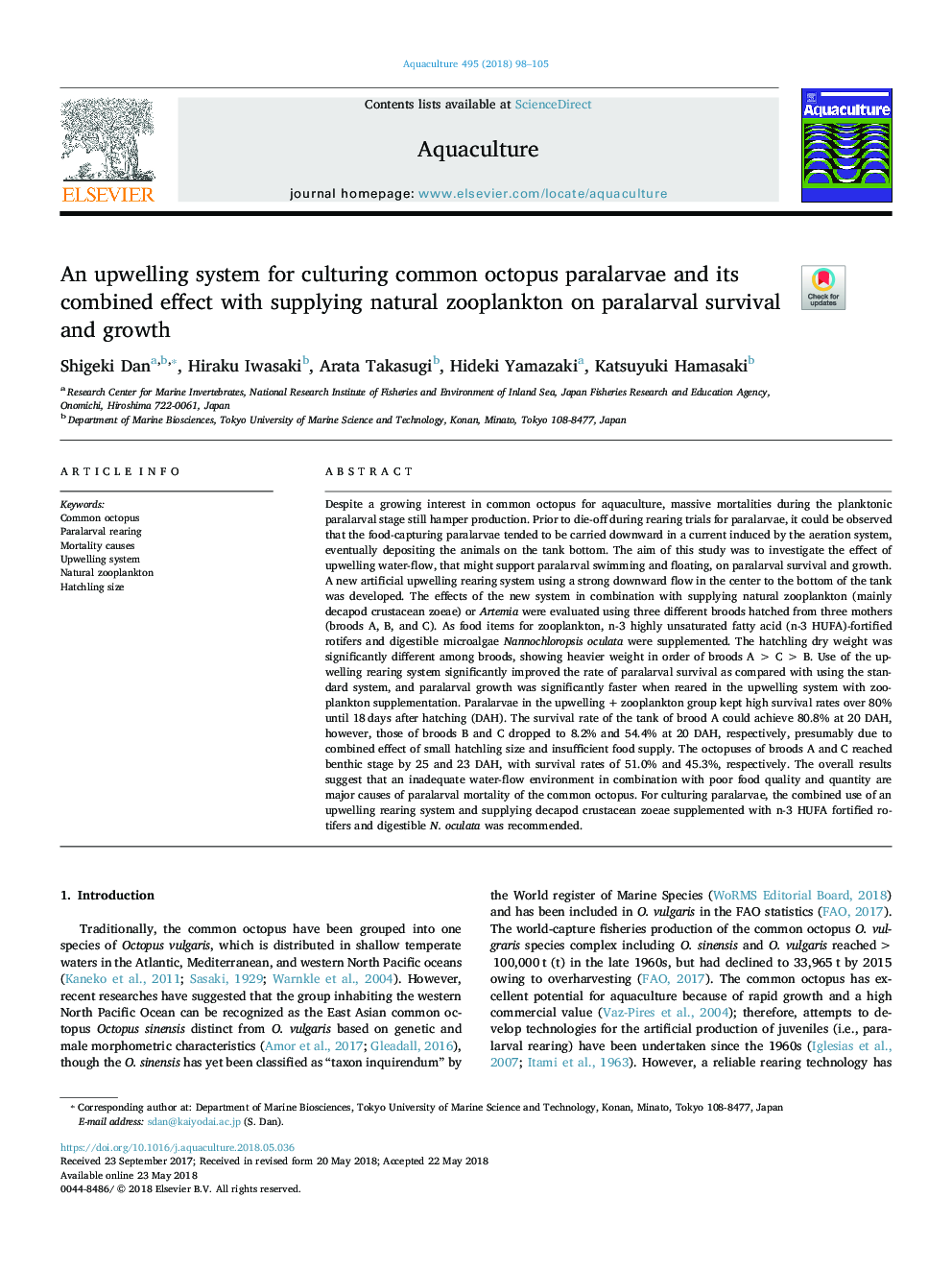| کد مقاله | کد نشریه | سال انتشار | مقاله انگلیسی | نسخه تمام متن |
|---|---|---|---|---|
| 8493095 | 1552793 | 2018 | 8 صفحه PDF | دانلود رایگان |
عنوان انگلیسی مقاله ISI
An upwelling system for culturing common octopus paralarvae and its combined effect with supplying natural zooplankton on paralarval survival and growth
ترجمه فارسی عنوان
یک سیستم آپولینگ برای کشت علف های هرز مشترک و اثر ترکیبی آن با تهیه زئوپلانکتون طبیعی بر روی بقا و رشد پارالاروال
دانلود مقاله + سفارش ترجمه
دانلود مقاله ISI انگلیسی
رایگان برای ایرانیان
کلمات کلیدی
موضوعات مرتبط
علوم زیستی و بیوفناوری
علوم کشاورزی و بیولوژیک
علوم آبزیان
چکیده انگلیسی
Despite a growing interest in common octopus for aquaculture, massive mortalities during the planktonic paralarval stage still hamper production. Prior to die-off during rearing trials for paralarvae, it could be observed that the food-capturing paralarvae tended to be carried downward in a current induced by the aeration system, eventually depositing the animals on the tank bottom. The aim of this study was to investigate the effect of upwelling water-flow, that might support paralarval swimming and floating, on paralarval survival and growth. A new artificial upwelling rearing system using a strong downward flow in the center to the bottom of the tank was developed. The effects of the new system in combination with supplying natural zooplankton (mainly decapod crustacean zoeae) or Artemia were evaluated using three different broods hatched from three mothers (broods A, B, and C). As food items for zooplankton, n-3 highly unsaturated fatty acid (n-3 HUFA)-fortified rotifers and digestible microalgae Nannochloropsis oculata were supplemented. The hatchling dry weight was significantly different among broods, showing heavier weight in order of broods Aâ¯>â¯Câ¯>â¯B. Use of the upwelling rearing system significantly improved the rate of paralarval survival as compared with using the standard system, and paralarval growth was significantly faster when reared in the upwelling system with zooplankton supplementation. Paralarvae in the upwellingâ¯+â¯zooplankton group kept high survival rates over 80% until 18â¯days after hatching (DAH). The survival rate of the tank of brood A could achieve 80.8% at 20 DAH, however, those of broods B and C dropped to 8.2% and 54.4% at 20 DAH, respectively, presumably due to combined effect of small hatchling size and insufficient food supply. The octopuses of broods A and C reached benthic stage by 25 and 23 DAH, with survival rates of 51.0% and 45.3%, respectively. The overall results suggest that an inadequate water-flow environment in combination with poor food quality and quantity are major causes of paralarval mortality of the common octopus. For culturing paralarvae, the combined use of an upwelling rearing system and supplying decapod crustacean zoeae supplemented with n-3 HUFA fortified rotifers and digestible N. oculata was recommended.
ناشر
Database: Elsevier - ScienceDirect (ساینس دایرکت)
Journal: Aquaculture - Volume 495, 1 October 2018, Pages 98-105
Journal: Aquaculture - Volume 495, 1 October 2018, Pages 98-105
نویسندگان
Shigeki Dan, Hiraku Iwasaki, Arata Takasugi, Hideki Yamazaki, Katsuyuki Hamasaki,
